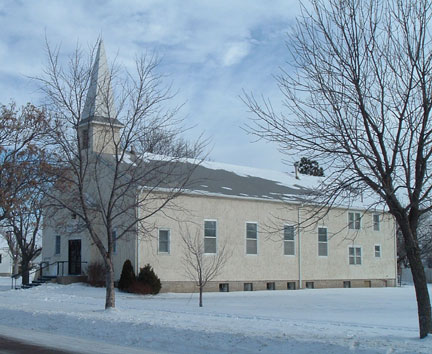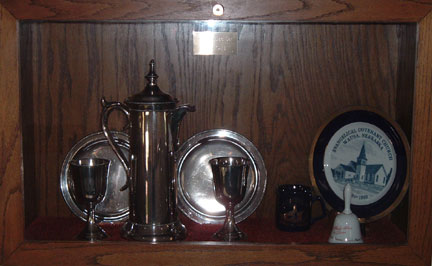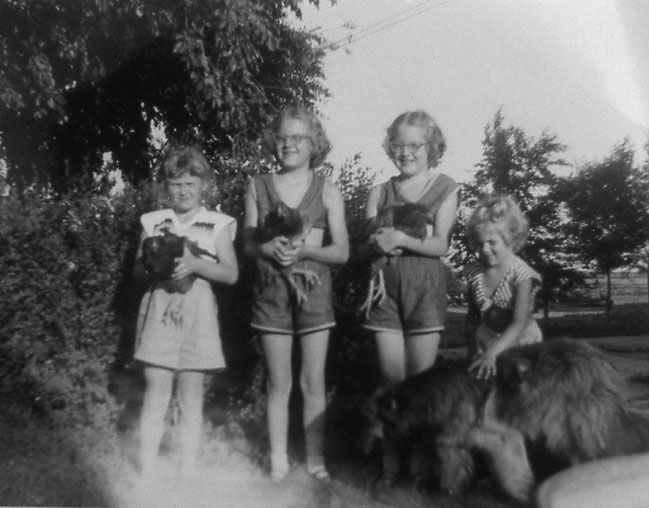Between Holdrege and Bertrand is the intermediate station, Loomis. The writer associates the name Loomis with two things: this town, which was the mailing address of the Westmark Church, and (2) a man well-known in his home town of Wausa, "Loomis" Johnson. Loomis roomed in the apartments over the bank in which our great-grandmother and later our grandparents lived. It was only after the centennial book for Wausa was published in 1990 that we learned that "Loomis" was not Mr. Johnson's real name. He was called Loomis because he had come from Loomis, Nebraska, and was called that to distinguish himself from another Johnson with the same first name! This is what I call "convergence."

Our only written source for the Swedish church in Loomis is the 50-year book of the Evangelical Free denomination. The congregation began with assistance from the Moses Hill rural church, detailed above. In sharing pastors with that church, it lists Mission Covenant stalwarts such as C.M. Youngquist and G.D. Hall as among its first leaders. Later, it apparently moved into the orbit of the Free Mission churches which surrounded it and became a Free church. There is no record of a Lutheran, or other Swedish denomination at work in Loomis.

The Loomis Free Church in the thirties

The specter of fire consumed the Loomis Free church as it had too many of the Phelps churches, but its present-day form as shown above attests to its healthy survival.

Falun-Norman
The design of the land agents was to have headquarters near the center of the areas in which land was available. This has been seen in the case of Bethany and Phelps Center. In spite of this, they could not predict where the actual railroad lines would end up, and so the populated areas shifted away from these early settlements to those along the rails. Follow our map above to the far right for the locations of Minden and Norman.
Eventually those areas on the extreme edges of the settlements would finally be occupied. There are some interesting stories of the churches which began "on the margins." One was begun by a cluster of Swedes from Vermont near the post office of May, in Kearney County. It was organized by a Lutheran mission pastor, Elias Peterson, who worked for the Synod Central Board out of Illinois. This raised the eyebrows of the Kansas Conference and later Nebraska Conference, when these mission stations were set up too close to existing Augustana parishes. This had been the case at Funk as well.

Falun Church
In any case, a church was built near May, called Falun, under the Augustana model constitution. Sandahl must report awkwardly that the congregation did not make its reports to the Conference, however, and seemed content to welcome visiting pastors not only from established parishes over in Phelps County, but those of the "sects" as well. That would mean Methodists and Mission friends, but might even extend beyond the "usual suspects," as we shall see. It would be a quarter century before a formal arrangement for a shared pastorate under Augustana auspices was established. The joint stations were alternately Minden, Kearney and Scandinavia. In the meantime, it would appear that the Falun congregation operated essentially as a "free" Lutheran church. Were they reading Martenson and Princell's Chicago-Bladet diatribes against denominational organization? Or had free-leaning Hallgren pointed them toward the Franson style churches? They manifestly kept no records, but this is of more substance than just an "argument from silence." The same phenomena is observed at Scandinavia.
Once the Nebraska Conference established its own mission program they were able to supply pastors whose designs did not conflict with existing works. One, named Moren, even had the ability to build his own churches, and did so for Falun to replace their earlier structure. Soon after, this building was moved into the town of Norman. This was probably another instance of the railroad station trumping the rural post office as the center of a community.

This community center is what remains of the Norman church
The remnant at May exhibited one last bit of independent-mindedness by building a new church near the original site, but under the banner of the Presbyterian church. As of the 1931 history, the Lutheran Falun-Norman church had fallen back to a shared pastorate once again, while the country Presbyterian Swedes were doing rather better. (This is the first instance the writer has encountered in which dissident Swedes became Presbyterian in Nebraska, but there may be others)

Only a cemetary remains at this rural site
of the Norman Lutheran and May Presbyterian churches
Minden

Nazareth at Minden
Mission work was also done in Minden, with active support from the Bethany "mother" church and the industrious Rev. O. Moren again serving as building contractor. He had in the meantime constructed a house for himself with lumber salvaged from Falun. Subsequent pastors complained that "Lutheran families sent their children to Reformed Sunday schools, and that Bethany members residing in Minden did not join here." The historian, who also was a Conference official, admits that it would probably be best if the church were to merge with the more numerous Danes in the community, the church in whose building they were originally organized. Danes built the home of mercy in Minden, which also was called Bethany. In a century, they would all be worshipping under the ELCA banner.

A few years after Sandahl's pessimistic opinion on the Minden church, lightening caused its demise. Add this to the list of churches destroyed by fire; Bethany Holdrege, Adullam Bertrand and the Loomis Free Mission church!

The first county seat of Phelps County was on the north edge of the county, near the Platte River. It was called "Williamsburg" and was intended to be along a railroad line which was never built. This marker makes an explanation which sounds more like a rail company's fabrication than a factual reason: "The Burlington and Missouri River Railroad planned a line from Lowell, Nebraska, to the 106th meridian, south of the Platte. This prompted C.J. Dilworth to promote the establishment of Phelps County. The county seat, Williamsburg, was named after Dilworth's son, William. Reports that crops could not be raised west of Ft. Kearny caused the B & M to cancel those plans, spelling the doom of Williamsburg which continued as the county seat until 1879 when an election moved the county seat to Phelps Center."

There stands a church at Williamsburg, and in spite of several Swedish names on its gravestones, was always an American Methodist congregation.
A question emerges, why do so few Swedish place names exist in the Svea Settlement; why is it identified by these non-Swedish sounding names such as "Phelps", "Holdrege", etc.? The earliest developers whose names appear in the marker above provide one answer. Dilworth fortunately did not attempt to memorialize himself in a place name, but gave that honor to his son, William, in the name "Williamsburg." For whatever reason, though Leander Hallgren was the leader in the development of "Phelp's Center", it was named in honor of the family name of Dilworth's wife, who was a Phelps. Perhaps "political" considerations figured in the choice. "Holdrege" acknowleged the role of the Burlington Railroad official of that name charged with the building of that line westward. At the end of the day, few Swedish place names mark the largest Swedish settlement in the state.

Not only Swedish churches have interesting stories. A rural Congregational church was moved to Holdrege for the use of a Seventh Day Adventist group.

This fascinating old church was once Episcopal; when that congregation moved to a former Presbyterian building it became an auction house.


It was moved to south Kearney and serves today as this Lutheran church!

The former Mormon building, now Johnson Lakeside chapel
One more observation about names. The Lutheran congregations were consistent in taking Biblical titles, with the one exception of Kearney. The Free churches followed Franson's formula of taking only their local post office as their title, with the one exception of Holdrege, which was called "Trinity." A few miles south of Bertrand was a congregation which was served in part by Free Mission ministers. It was known only as the "Frank Naylor Church." It was said to have been served at one time by one of those curious teams of "prophesying daughters" (Franson's term), a Mabel Karlberg and a Miss Nelson. We have noted that the Salvation Army also employed such female team ministries.


Trailmap
This very interesting reconstruction of the 1908 trails / roads of Phelps County is found in their centennial book. It places a number of the earliest churches, now well "off the roads", directly on the earlier thoroughfares and helps us to realize that originally they were very much "on the roads."
In our numbering we have gone from upper left to lower right, but historically the pattern would be different. Some of the oldest settlements would be in the lower right, with the exception of Phelps Center which is appropriate to its name and the meeting point of three major trails. This map helps one visualize Phelps County before the railroads and modern highways existed; a challenging task.
1) Adullam
We have had to adjust our picture of where Axelson was located. It is not close to the Westlandia site at all, but north of the site chosen for Adullam when that congregation separated from Westlandia. It is also near the meeting point of two trails.
2) Westlandia
Located right on the major north-south trail along the western side of Phelps County. The cemetary remains.
3) Holcomb
Located right on the central north-south trail. A large modern church marks the spot.
4) Phelps Center
Self-explanatory.
5) Emmaus
This little survivor was once on the main trail across east-central Phelps
6) Bethel
Called "Swedish Lutheran Chapel" on this map, this is the site of one of the sod churches of Phelps County. A marker and cemetary remain though Bethel moved into Holdrege.
7) Prairie Zion
This Swedish Methodist church is just down the trail from number 6 and predates the Holdrege Swedish Methodist church. Only memories remain.
On a personal note, it is interesting that two trails traverse section 14 of Westside township where Eleanor grew up; one the legendary Oregon Trail. School district 2 stands next to her home.
A remaining question: where was Lutheran lay pastor and homesteader Olaf Hedlund's "Blacksmith Ranch?" Sandahl has this post office / waystation along the Kearney-Orleans trail which is shown on the lower right. He is also reported to have a homestead "east of Holdrege."
Altar Vessels

Artifacts
For those of us from a later generation, these objects have never been seen in use. On a visit to my home church (Mission) later that year, I was again startled to see a similar altar set on display. I had not known it existed. For our generation, the communion vessels consisted of stacked trays of individual cups and wafers. What had caused the ornate altar sets to disappear?
Consider these ideas: In Sweden, the mission societies which were organized within the state church parishes in the 1800's frequently followed the earlier anabaptists in objecting to observing communion with the "worldly." In conceding this right to the societies, the state church officials only required that an ordained priest administer the sacraments. There were many believing priests who would pass muster with the mission societies, the best known being Waldenström himself.
Citing some passages in Luther, and with an eye to the practices of the separatist Baptists at home and abroad, even the practice of lay administration of communion was advocated by some. It was, after all, a "priesthood of all believers." The rub for separatistic practices in Sweden was their illegality. In America the mission friends found no such strictures. Here they might achieve valid clerical status through the simple congregational practice of the local church ordaining its own minister. He would be the one to administer the sacraments.
But, "not so fast." No Swedish immigrant congregation that I know of rushed to advance one of its own members to become pastor without ordination. For one thing, the mode of ministry was closer to the colporteur practice in Sweden and not very different from the American Methodist circuit rider. A layman might read a sermon in the absence of a pastor, as Björk famously did, but communion would wait till a duly ordained minister was present. The history of the immigrant church reveals a hunger for proper church buildings, proper church documents and properly ordained ministers. The altar vessels which we see preserved in the museum affirm this.
The leading pastors among the immigrant Swedes were the products of the colporteur schools of Sweden such as that conducted by Fjellstedt and Ahlberg. In America there was an early impulse to validate pastoral credentials in the American way; noteably by ordination in an American Lutheran body. This is central to the story of the formation of the Augustana Synod. There was lively correspondence between Ahlberg in Sweden and Esbjörn and Hasselquist on this side of the Atlantic concerning pastoral candidates.
Though they took many cues from the American Lutherans, the Augustana Swedes stopped short of the high churchly position taken by their countryman, Unonius. He ranged among the American settlements urging their affiliation with the Episcopal Church and insisting that only a bishop could properly ordain ministers. The Augustana formula was to ordain its ministers, and make its denominational decisions, in annual assemblies representing its churches. This has been called the "Presbyterian" form of polity...an American accommodation.
When some of the mission friends separated from Augustana, they did not initially pursue the local ordination route, but rather formed synodic structures similar to Augustana's which could perform that task. The mode of local ordination seemed to grow out of exposure to the Moody church of Chicago and was implemented by the "Free" Mission congregations. Even in the latter group it might be noted that the first formal organization in Nebraska was one of ministers, who formed a ministerium with the help of Franson in Oakland. The idyllic notions of total local autonomy with each congregation ordaining one of its own to its ministry may have thrived "on paper" in the pages of Martenson's Chicago-Bladet, but in practice the dream soon evaporated.
What is seen is a rapid movement to a settled form of pastoral ministry. It is the corollary to the equally rapid movement to the building of churches. In cases like S.G. Larson in Saunders County and J. Peterson in Burt County, the pastor might become a homesteader but not just any homesteader could be a pastor. David Nyvall observed that the mission friends prefered the title "preacher" to "priest" or even "pastor"; that was in reaction to the clergy class of Sweden. He also pictures these preachers as "shared" by the congregations...though that may date from the time when there were too few to go around. There was extensive itinerating by the early pastors for this very reason, and each of the denominations employed "missionary" pastors in the state. But the trend was toward settled pastorates.
By becoming homesteaders themselves, the pastors both ensured their own economic survival in the early empoverished years and established a parochial permanence in their work. We might suggest that this permanence was more prevalent in these early years than would be the case later on. There was strength in being a neighbor and landowner in a congregation rather than one who might be seen as a temporary employee. Norelius in Minnesota, Halland in Iowa, S.G. Larson in Nebraska, and others, all owned land in their parishes. Free Mission pastors Falk and Sweders at Stromsburg, as well as Baptist pastor Lundgren had farms. These we have discovered in spite of the later tendency to omit "unprofessional" details.
In all of this, the ministerium of the immigrant churches was beginning to look more traditional. The matter of vestments was a live one, and as in many American churches it was popular to abandon the robes of priesthood.
Counter to all of this stands the mute witness of the Phelps museum. What we see there may be a fossil, but it is a fossil which once lived. These are vessels of priesthood. They recall a day when the sacrament of the altar was practiced with a common cup, and at the altar rail. Communion was administered to each believer by one pastor, according to good order, just as it had been done in Sweden!

Altar vessels of the "Swedish Christian Congregation of Wausa"
It was done in the Lutheran church (quite naturally), but also in the Methodist, the Mission Synod, and even the Free Mission Church. This is "exhibit A" for our thesis that, in America, there were "Lutheran Baptists", "Lutheran Methodists", "Lutheran Mission Friends" and "Lutheran Free." Or, put another way, they were "Swedes first and anything else second. " These silent symbols tell a story that otherwise might be completely lost!
Some observe that receiving the sacrament by the passing of trays is the more hygienic method. Whether that be true or not, it reminds us of this story about Waldenström. He was called on the carpet for communing with a sectarian group at one of their meetings in Sweden. His response was, that he had not taken the sacrament with them, as they merely passed a tray among themselves in some Reformed symbolic gesture!

Northern Phelps County from the air: irrigation canals criss-cross the region. The Johnson feed yards surround Eleanor's home with the Platte in the distance. Who said no crops could be raised west of Kearney?

Eleanor's dad, Alwyn, a preserver of sod church country transportation
Here he shows his Belgians at the state fair

The Johnson kids with some family chickens